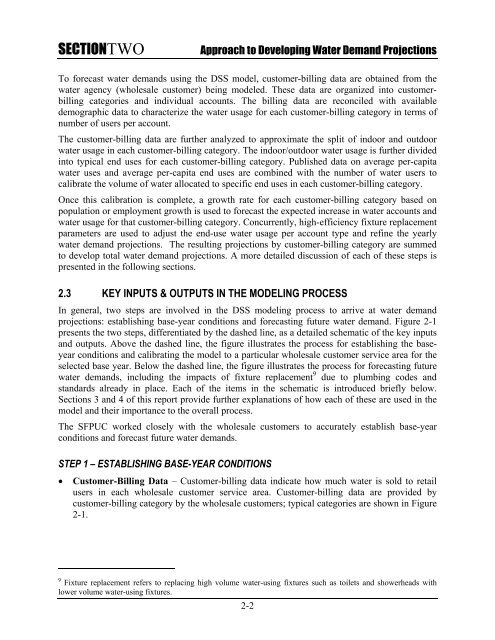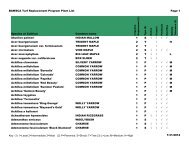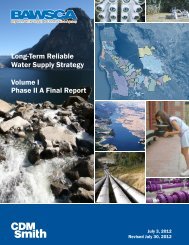SFPUC Wholesale Customer Water Demand Projections ... - BAWSCA
SFPUC Wholesale Customer Water Demand Projections ... - BAWSCA
SFPUC Wholesale Customer Water Demand Projections ... - BAWSCA
Create successful ePaper yourself
Turn your PDF publications into a flip-book with our unique Google optimized e-Paper software.
SECTIONTWO<br />
Approach to Developing <strong>Water</strong> <strong>Demand</strong> <strong>Projections</strong><br />
To forecast water demands using the DSS model, customer-billing data are obtained from the<br />
water agency (wholesale customer) being modeled. These data are organized into customerbilling<br />
categories and individual accounts. The billing data are reconciled with available<br />
demographic data to characterize the water usage for each customer-billing category in terms of<br />
number of users per account.<br />
The customer-billing data are further analyzed to approximate the split of indoor and outdoor<br />
water usage in each customer-billing category. The indoor/outdoor water usage is further divided<br />
into typical end uses for each customer-billing category. Published data on average per-capita<br />
water uses and average per-capita end uses are combined with the number of water users to<br />
calibrate the volume of water allocated to specific end uses in each customer-billing category.<br />
Once this calibration is complete, a growth rate for each customer-billing category based on<br />
population or employment growth is used to forecast the expected increase in water accounts and<br />
water usage for that customer-billing category. Concurrently, high-efficiency fixture replacement<br />
parameters are used to adjust the end-use water usage per account type and refine the yearly<br />
water demand projections. The resulting projections by customer-billing category are summed<br />
to develop total water demand projections. A more detailed discussion of each of these steps is<br />
presented in the following sections.<br />
2.3 KEY INPUTS & OUTPUTS IN THE MODELING PROCESS<br />
In general, two steps are involved in the DSS modeling process to arrive at water demand<br />
projections: establishing base-year conditions and forecasting future water demand. Figure 2-1<br />
presents the two steps, differentiated by the dashed line, as a detailed schematic of the key inputs<br />
and outputs. Above the dashed line, the figure illustrates the process for establishing the baseyear<br />
conditions and calibrating the model to a particular wholesale customer service area for the<br />
selected base year. Below the dashed line, the figure illustrates the process for forecasting future<br />
water demands, including the impacts of fixture replacement 9 due to plumbing codes and<br />
standards already in place. Each of the items in the schematic is introduced briefly below.<br />
Sections 3 and 4 of this report provide further explanations of how each of these are used in the<br />
model and their importance to the overall process.<br />
The <strong>SFPUC</strong> worked closely with the wholesale customers to accurately establish base-year<br />
conditions and forecast future water demands.<br />
STEP 1 – ESTABLISHING BASE-YEAR CONDITIONS<br />
• <strong>Customer</strong>-Billing Data – <strong>Customer</strong>-billing data indicate how much water is sold to retail<br />
users in each wholesale customer service area. <strong>Customer</strong>-billing data are provided by<br />
customer-billing category by the wholesale customers; typical categories are shown in Figure<br />
2-1.<br />
9 Fixture replacement refers to replacing high volume water-using fixtures such as toilets and showerheads with<br />
lower volume water-using fixtures.<br />
2-2







